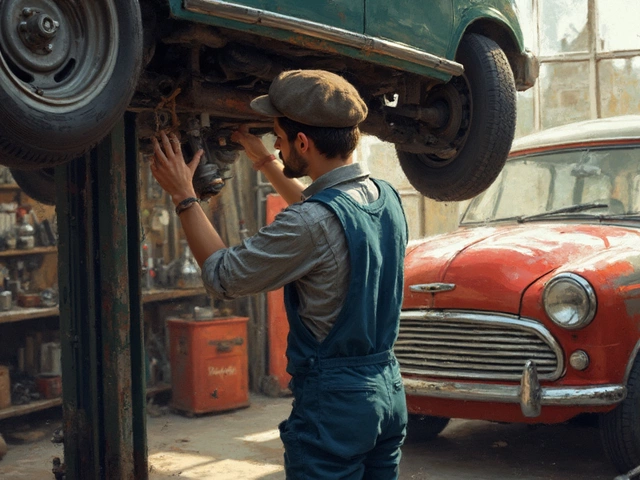Neglect your radiator and your car can go from road-trip ready to roadside emergency in no time. Radiators are the kind of part most drivers forget about—until the temp needle shoots up or a puddle crawls out from under your ride. Yes, a radiator might look tough, full of metal and tubes. But it’s the quiet, hardworking middleman keeping your engine from frying itself to oblivion. So, if you're wondering how often you really need to replace this unsung hero, stick around. The real answer depends on a lot more than what the service manual says.
How Radiators Really Age: More Than Just Miles
First things first, the idea that a radiator lasts a certain number of miles is just half the truth. It’s not like hitting 100,000 miles triggers a radiator meltdown. Instead, think of your radiator as aging by exposure—heat cycles, corrosion, and your driving habits play a huge part. On average, a modern radiator can last anywhere from 7 to 10 years. That’s if you’re keeping up with coolant changes and not pushing your engine too hard. If you’re the set-it-and-forget-it type who never checks under the hood, you could be looking at needing a replacement as soon as five years.
Let’s hit some facts: in 2023, AAA reported that overheating was responsible for 15% of all roadside breakdowns in the U.S., and the radiator is usually at the heart of it. Cars living in areas with harsh winters or salty roads (hello, Northeast) get the short end of the stick—road salt speeds up corrosion from the inside out. And it’s not just about age or rust. Tiny leaks or mineral deposits from tap water can clog up the fins, making it harder for the radiator to do its job. It’s like trying to breathe through a pillow—your car just can’t stay cool enough.
Here’s a useful trick: next time you’re under the hood, look at the radiator caps and hoses. If you see white or green residue, that’s coolant oozing where it shouldn’t. Feel around for soft spots on hoses—squishy means rot or internal leaks. The costliest replacement jobs often start out as small leaks that go ignored.
And here’s the kicker, radiator materials matter. Aluminum radiators last longer than copper-brass ones, mostly because aluminum doesn’t rust the same way. If you drive a newer vehicle, odds are you’ve got an aluminum radiator. Classic cars? Those probably still have copper-brass units that may need restoring or replacing more often. Check your owner’s manual or ask your mechanic what’s in your car.

Common Signs Your Radiator Is on Its Last Legs
Spotting a dying radiator early saves cash, hassle, and sometimes your whole engine. Problem is, the warning signs often hide in plain sight. If you keep seeing your temperature gauge spike on summer days or get a mysterious puddle in your driveway, pay attention. Newer cars have warning lights, but don’t rely on those alone. By then, it might be too late.
Coolant leaks make up the most obvious sign. Pop the hood and look around the radiator seams, especially along the top and bottom tanks. If you see moisture or dry, crunchy coolant residue, chances are there’s a hairline crack. Another red flag is rust—check along the radiator’s edges for reddish-brown grime. Even a little rust can lead to pinholes that leak under pressure.
If your heat takes forever to warm up, your radiator might not be circulating coolant effectively. Or, you might notice the air conditioner struggling more than usual, especially at low speeds when airflow drops. Worse still, sometimes the radiator fins clog up with debris, bugs, or even leaves. This blocks airflow and sends coolant temps up, especially if you do a lot of city driving.
Don’t ignore odd engine smells. If you ever catch a sweet, syrupy smell inside your car, that’s ethylene glycol, the main ingredient in coolant. Leaks and overheated coolant give off that tell-tale odor—think of it like your car screaming for help.
Let’s get specific. Here’s a quick table laying out the key red flags and what they usually mean:
| Symptom | Likely Cause |
|---|---|
| Rising temp gauge | Poor coolant flow, internal clog, or loss of coolant |
| Coolant puddle under car | Radiator crack or split tank |
| Rust stains around radiator | Moisture from leaks or condensation leading to corrosion |
| Sweet smell in cabin | Leaking coolant, possibly through the heater core or hoses |
| Air bubbles in coolant reservoir | Blown head gasket or air entering from a radiator leak |
| Frequently topping off coolant | Chronic leak in radiator or associated hoses |
Want to make your radiator last? Stick to quality coolant and change it every 2 to 4 years, depending on your car’s spec. Don’t mix coolant colors—stick to whatever came with your car from the factory. Mixing can cause chemical reactions that eat away at internal seals or metal surfaces. And don’t use plain water, unless it’s an emergency. Hard water minerals gunk up the tiny passages inside the radiator, cutting efficiency fast.

Replacement Timing and Money-Saving Maintenance Tips
Here’s the million-dollar question—should you run your radiator till it fails, or swap it out pre-emptively? Most mechanics won’t tell you to change it at a set mileage, but you don’t have to wait for a meltdown either. A practical rule of thumb: check the radiator and cooling system every 30,000 miles or two years, whichever comes first. Look for leaks, corrosion, warping, discoloration, and check coolant quality in the reservoir. If you see brown sludge or floating debris, it’s probably time for a flush or a new radiator.
Money-wise, swapping a radiator isn’t as bank-breaking as you’d think, but letting a bad one cook your engine can mean thousands in repair bills. As of June 2025, the average radiator replacement in the U.S. runs about $650 for most mid-size sedans—luxury rides, oversized trucks, and imports can cost double that. Labor tends to cost as much as the part. Shopping around and using an independent shop vs. a dealership can save you a few hundred bucks.
If you’re handy, swapping a radiator is doable in your own garage with some basic tools. The biggest pain? Draining the nasty old coolant and refilling the system—make sure you recycle coolant properly and bleed air out so your engine doesn’t overheat later. Always replace any old hoses, clamps, or radiator caps when you do the job; a weak link here means leaks down the road.
Maintenance isn’t just about the radiator itself. Keeping the cooling system healthy protects the water pump, thermostat, heater core, and head gaskets. If any part fails, it puts extra strain on everything else. Here’s a quick tip list to help you squeeze every mile out of your radiator:
- Flush and refill with fresh coolant every 2-4 years (never just top off!)
- Inspect for leaks and rust every oil change
- Use distilled water if you ever need to mix your own coolant
- Replace worn hoses and your radiator cap as soon as you spot problems
- Keep radiator fins clean—carefully spray with a garden hose, not high pressure
- Don’t ignore weird engine smells or rising dashboard temps
- Consider a radiator protection sealant in older cars as a stop-gap (but never a permanent solution)
Ever notice how some rides in hot states like Texas or Arizona chew through radiators twice as fast? Those high heat cycles, combined with dust and debris, break down seals faster. City driving is brutal too—stopping and going traps more heat in your engine bay, letting the coolant cook for longer stretches. Compare that to highway miles, where constant airflow helps cool everything down.
Some newer cars now use electric water pumps and smart thermostats. These upgrades improve efficiency and sometimes help radiators last longer, but regular checks on coolant and leaks are still critical. Technology helps, but you can’t ignore the basics.
Bottom line: treat your radiator replacement as an ounce of prevention, not a reaction to disaster. A healthy radiator means a healthy engine, fewer surprise repairs, and more worry-free miles wherever you go. Don’t wait for steam to start pouring out of your hood—use what you’ve learned to stay ahead of breakdowns, and your car (and wallet) will thank you.



